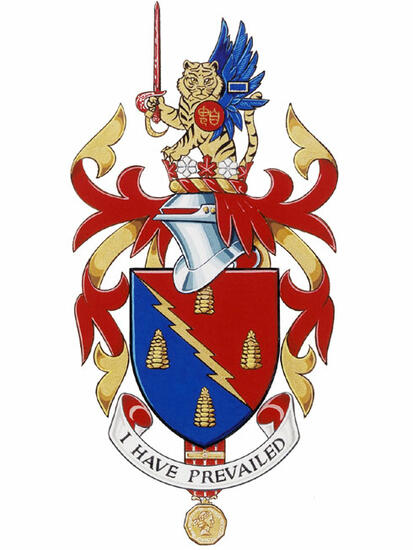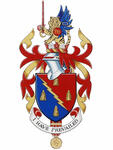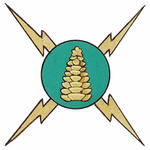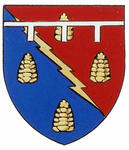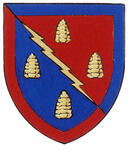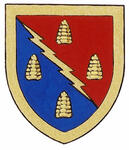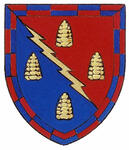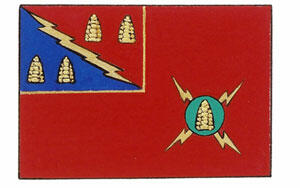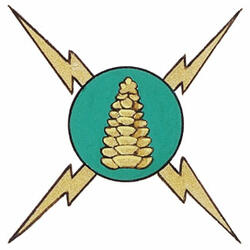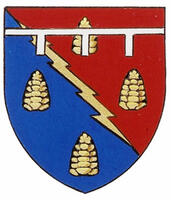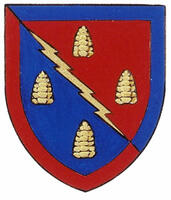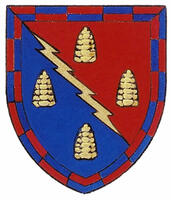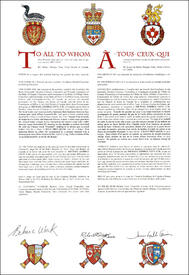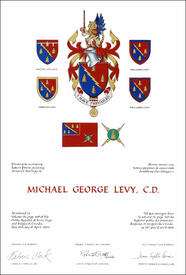The contents of this Register are intended for research purposes only. The heraldic emblems found in the Register may not be reproduced in any form or in any media without the written consent of the Canadian Heraldic Authority and/or the recipient.
Richmond, British Columbia
Grant of Arms, Flag and Badge, with differences to Michael Guy Levy, Don Garry Levy, Linda Gay Levy, and Paul Garth Levy
April 15, 2004
Vol. IV, p. 369
Arms of Michael George LevyBlazonPer bend Gules and Azure overall a lightning flash bendwise between four Korean pine cones (Pinus koraensis) Or; SymbolismThe colours red, blue and gold are the regimental colours of Major Levy’s regiment, the Princess Patricia’s Canadian Light Infantry. The diagonal division symbolizes the rough terrain of the battle of Kapyong, the engagement in which Major Levy gave distinguished service. The lightning flash represents the wireless unit used by Major (then Lieutenant) Levy to call for artillery fire in the battle, and it also refers to the glare and heat of battle. There are ten points on the flash, referring to the number of Major Levy’s platoon. The Korean pine is the county tree of the county of Kapyong. It is a beautiful evergreen with very large cones that contain edible fruit. Here it refers to the part of Korea where Major Levy acted so heroically. The number of cones represents his four children. Cones generally are a sign of new life, so here they can represent new beginnings arising after a fierce and deadly battle. |
CrestBlazonIssuant from a circlet of maple leaves Gules and dogwood flowers Argent, a demi tiger guardant Or, striped Sable, winged Azure, charged on the sinister wing with a billet fesswise Azure fimbriated Or, bearing on the shoulder a torteau inscribed Or with the Chinese word "Freedom", holding in its dexter paw a sword Gules; SymbolismThe floral circlet honours Major Levy’s service to Canada and his home in British Columbia. The word “Freedom”, in Chinese characters, represents his own escape to freedom at age 18 from a Japanese internment camp in Shanghai. The tiger is the insignia of the Special Operations Executive (SOE) Force 136, with which Major Levy parachuted behind enemy lines and fought with in Malaya during World War II. As a creature of strength and determination, the tiger also represents Major Levy’s own spirit. The wings refer to his dramatic flight across free China to India, his journey to Malaya, and his varied overseas post-World War II service. The sword is a classic symbol for a military officer, representing his defence against enemy attack and his skill in battle. The blue rectangle edged in gold on the tiger’s wing represents the unique Distinguished Unit Citation awarded by the President of the United States to Major Levy’s Regiment for their extraordinary heroism and combat performance at Kapyong. |
MottoBlazonI HAVE PREVAILED; SymbolismIt indicates Major Levy’s ultimate triumph through many harrowing challenges. |
Badge of Michael George LevyBlazonTwo lightning flashes in saltire Or surmounted by a pomme charged with a Korean pine cone (Pinus koraensis) Or; SymbolismThe flashes repeat the symbolism of the shield. The green disc refers to the Jade Trail across China, which Major Levy used for part of his escape from the internment camp in Shanghai. The cone refers again to Kapyong and his exploits in battle as well as the promise of a new start. |
Differenced Arms for Michael Guy Levy, son of Michael George LevyBlazonThe Arms of Michael George Levy debruised of a three-point label Argent; this individual will inherit the Arms of the Recipient following his or her death; SymbolismThe symbolism of this emblem is found in other element(s) of this record. |
Additional InformationCreator(s)Original concept of Robert D. Watt, Chief Herald of Canada, assisted by the Heralds of the Canadian Heraldic Authority PainterLinda Nicholson CalligrapherNancy Ellis Recipient TypeIndividual |

